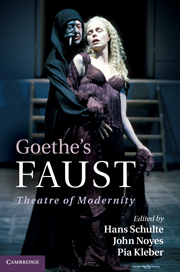Book contents
- Frontmatter
- Contents
- List of illustrations
- List of contributors
- Preface
- List of abbreviations
- Introduction
- PART I MODERNITY
- PART II THEATRE
- 13 Goethe's Faust: theatre, meta-theatre, tragedy
- 14 Faust beyond tragedy: hidden comedy, covert opera
- 15 Theatricality and experiment: identity in Faust
- 16 Rhetorical action: Faust between rhetoric, poetics and music
- 17 Directing Faust: an interview
- 18 A contradictory whole: Peter Stein stages Faust
- 19 Re-thinking and staging Goethe's Faust at the State Theatre Stuttgart 2005–6
- 20 Strehler's Faust in performance
- Select bibliography
- Index
- References
16 - Rhetorical action: Faust between rhetoric, poetics and music
Published online by Cambridge University Press: 01 June 2011
- Frontmatter
- Contents
- List of illustrations
- List of contributors
- Preface
- List of abbreviations
- Introduction
- PART I MODERNITY
- PART II THEATRE
- 13 Goethe's Faust: theatre, meta-theatre, tragedy
- 14 Faust beyond tragedy: hidden comedy, covert opera
- 15 Theatricality and experiment: identity in Faust
- 16 Rhetorical action: Faust between rhetoric, poetics and music
- 17 Directing Faust: an interview
- 18 A contradictory whole: Peter Stein stages Faust
- 19 Re-thinking and staging Goethe's Faust at the State Theatre Stuttgart 2005–6
- 20 Strehler's Faust in performance
- Select bibliography
- Index
- References
Summary
GOETHE'S RHETORIC
The modern restriction of rhetoric to a ‘rhetoric of tropes’ seen as a ‘modernist return of rhetoric’, or ‘rhetoricality’ in an overall sense is historically derived from a ‘discontinuity within tradition’, from a ‘historical gap’ between Enlightenment and (post-)modernity. It postulates an ‘end of rhetoric’ in the era of Romanticism. Goethe's rhetoric is situated in a crucial period, when this tradition still exists but aesthetic theories and stylistics are bringing it to an end. Theories of staging, even Goethe's famous and most disputed ‘Regeln für Schauspieler’ (Rules for Actors), are seen apart from their rhetorical tradition and context. Goethe himself never underestimated the art of persuasion. His rhetoric marks an epoch in the history of rhetoric. Rhetorical theory can be traced up to his concept of Weltliteratur, which proves to be a cornerstone of a new nineteenth-century rhetoric.
Introducing the term of rhetorical actio, the last stage of the opus rhetoricum, as a leading concept into an analysis of Goethe's major work Faust opens rhetorical analysis anew to questions of ‘performance’, theatricality, musicality and mediality. In fact, the Romantic era of transition can be examined as a period of aesthetic and medial transformation of rhetoric itself. Rhetoric in Goethe's Faust has to be examined not only as a relic of tradition, but also as a formative and performative element in a process of transformation of rhetoric, from classicist through Romantic to modern rhetoric.
- Type
- Chapter
- Information
- Goethe's FaustTheatre of Modernity, pp. 253 - 266Publisher: Cambridge University PressPrint publication year: 2011



